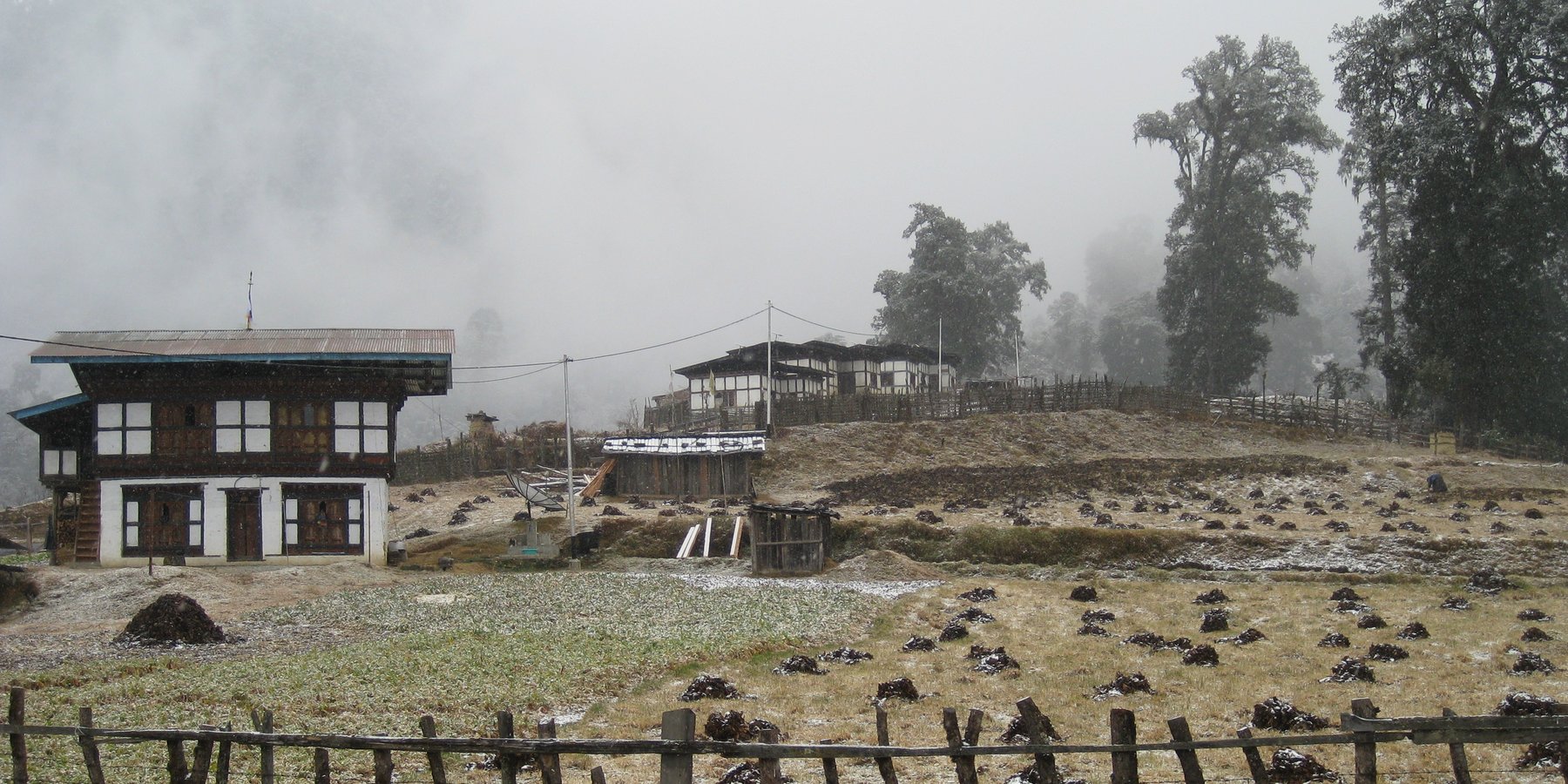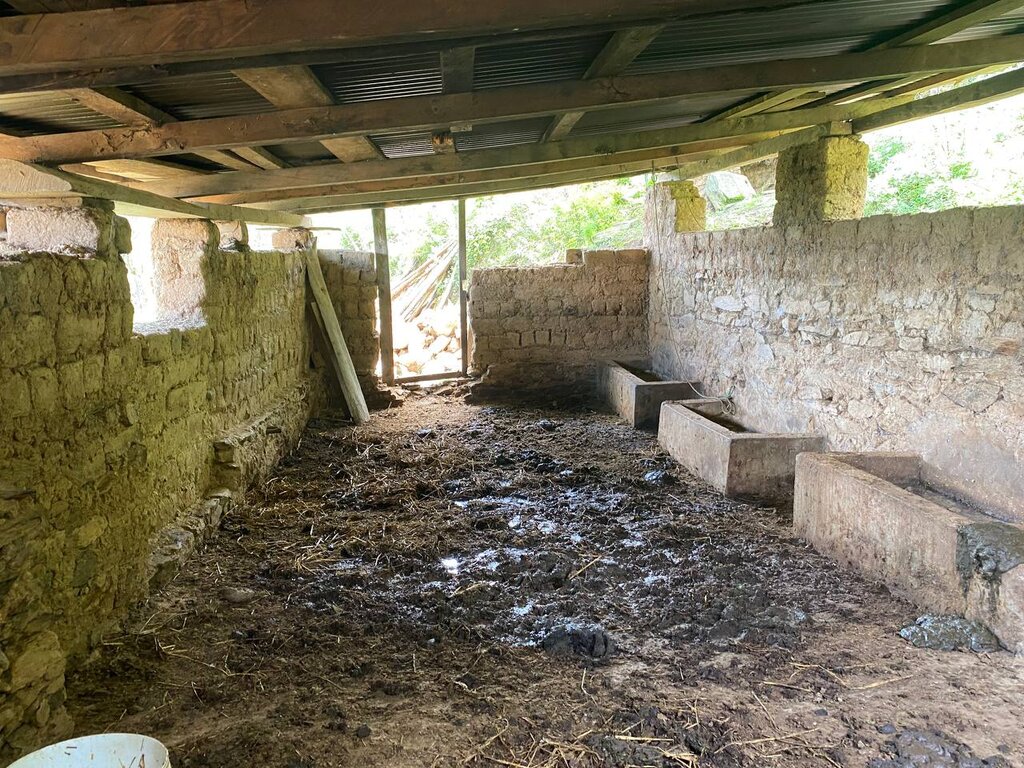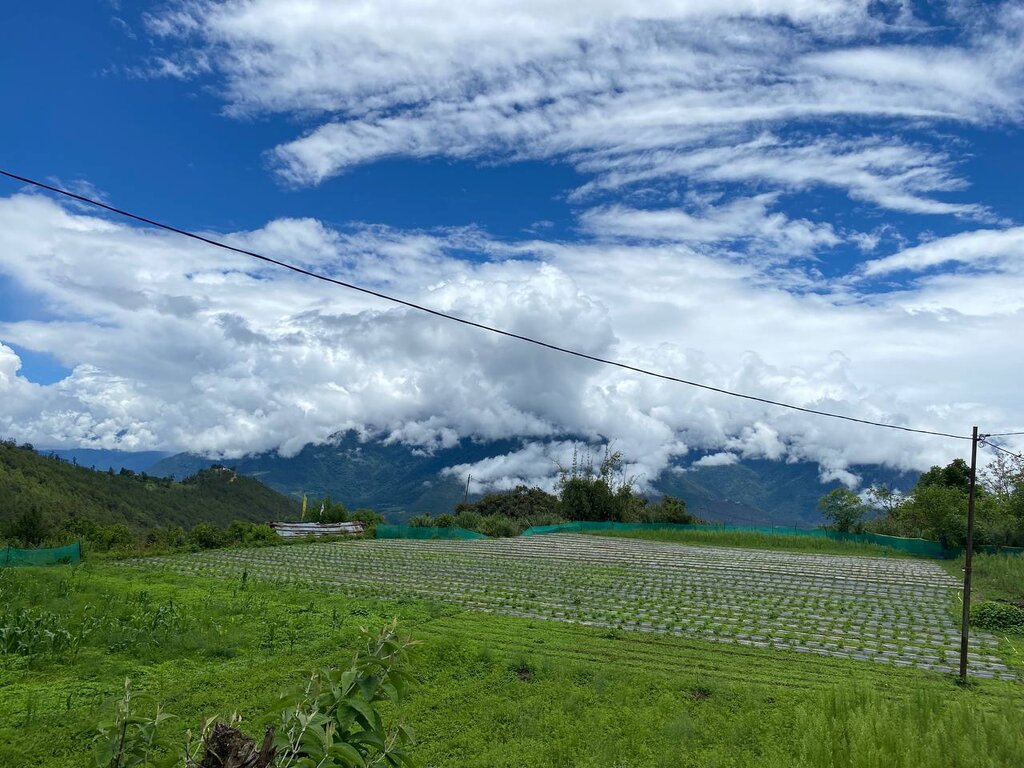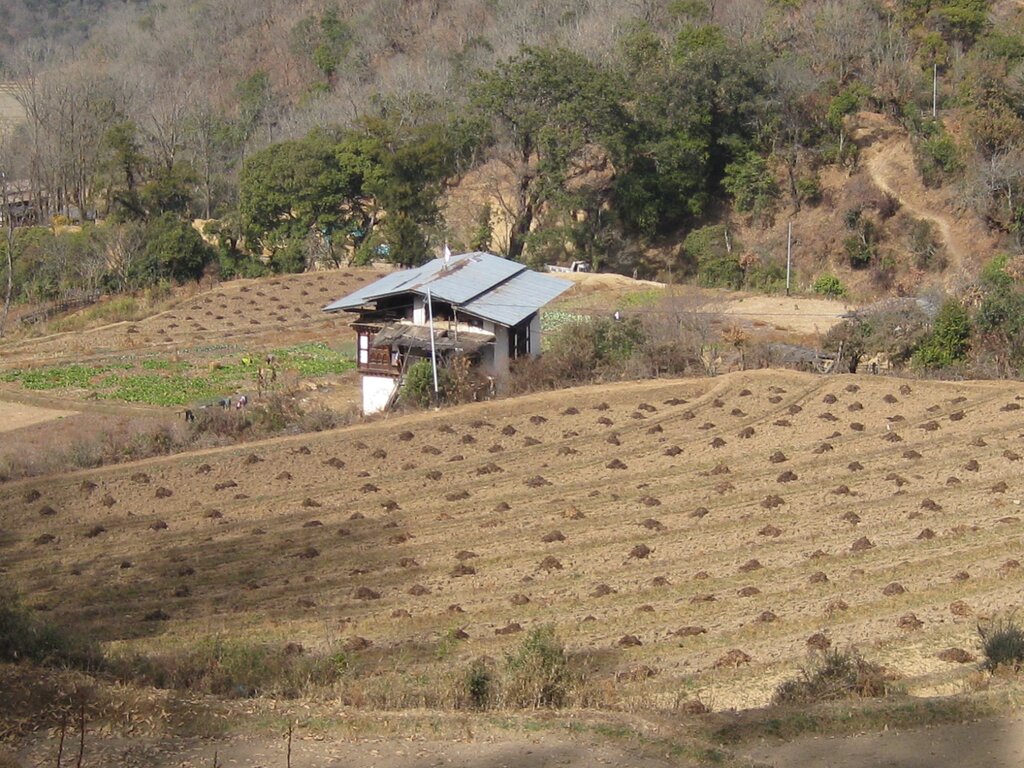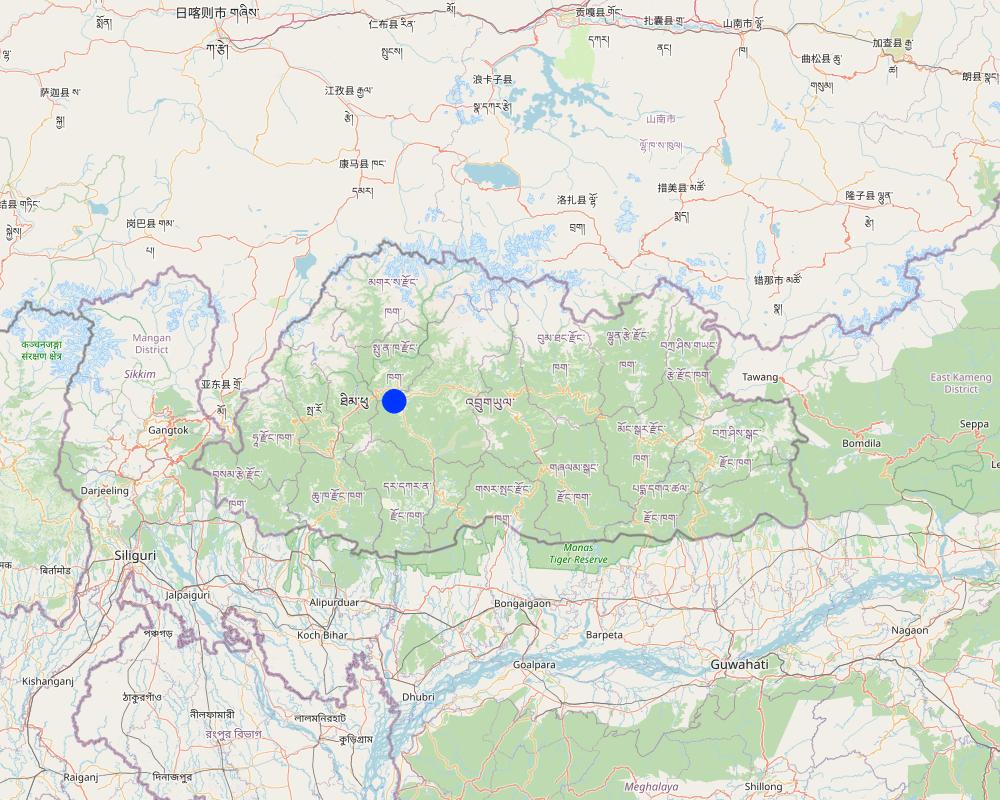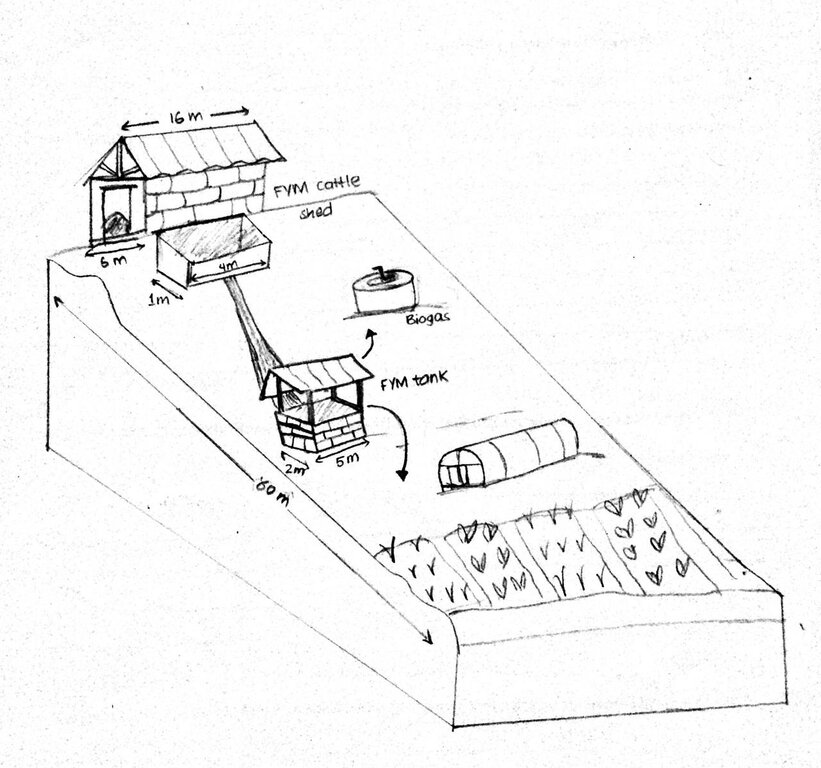Traditional Soil Fertility Management through FYM Application [ภูฏาน]
- ผู้สร้างสรรค์:
- การอัพเดท:
- ผู้รวบรวม: Karma Wangdi
- ผู้เรียบเรียง: Kuenzang Nima
- ผู้ตรวจสอบ: William Critchley, Rima Mekdaschi Studer, Joana Eichenberger
Nor Lue Luktey Sa Chue Zinchong (ནོར་ལུད་བླུགས་ཏེ་ས་བཅུད་འཛིན་སྐྱོང་།)
technologies_6822 - ภูฏาน
ดูส่วนย่อย
ขยายทั้งหมด ย่อทั้งหมด1. ข้อมูลทั่วไป
1.2 รายละเอียดที่ติดต่อได้ของผู้รวบรวมและองค์กรที่เกี่ยวข้องในการประเมินและการจัดเตรียมทำเอกสารของเทคโนโลยี
วิทยากรหลัก
ผู้ใช้ที่ดิน:
Zam Sonam
Tshokhorthangkha, Khujula, Wangdue phodrang
ภูฏาน
ชื่อของโครงการซึ่งอำนวยความสะดวกในการทำเอกสารหรือการประเมินเทคโนโลยี (ถ้าเกี่ยวข้อง)
Strengthening national-level institutional and professional capacities of country Parties towards enhanced UNCCD monitoring and reporting – GEF 7 EA Umbrella II (GEF 7 UNCCD Enabling Activities_Umbrella II)ชื่อขององค์กรซึ่งอำนวยความสะดวกในการทำเอกสารหรือการประเมินเทคโนโลยี (ถ้าเกี่ยวข้อง)
National Soil Services Centre (National Soil Services Centre) - ภูฏาน1.3 เงื่อนไขการใช้ข้อมูลที่ได้บันทึกผ่านทาง WOCAT
ผู้รวบรวมและวิทยากรหลักยอมรับเงื่อนไขเกี่ยวกับการใช้ข้อมูลที่ถูกบันทึกผ่านทาง WOCAT:
ใช่
1.4 การเปิดเผยเรื่องความยั่งยืนของเทคโนโลยีที่ได้อธิบายไว้
เทคโนโลยีที่ได้อธิบายไว้นี้เป็นปัญหาของความเสื่อมโทรมโทรมของที่ดินหรือไม่ จึงไม่ได้รับการยอมรับว่าเป็นเทคโนโลยีเพื่อการจัดการที่ดินอย่างยั่งยืน:
ไม่ใช่
แสดงความคิดเห็น:
Since this technology has been practiced from the olden days
2. การอธิบายลักษณะของเทคโนโลยี SLM
2.1 การอธิบายแบบสั้น ๆ ของเทคโนโลยี
คำจำกัดความของเทคโนโลยี:
Traditional soil fertility management refers to the practice of improving and maintaining soil fertility using organic amendments, specifically farmyard manure (FYM). Other organic materials and crop residues can be effectively utilized through process of decomposition, fermentation and pyrolysis to produce compost, bokashi and biochar respectively.
2.2 การอธิบายแบบละเอียดของเทคโนโลยี
คำอธิบาย:
Traditional soil fertility management refers to the practice of improving and maintaining soil fertility using organic amendments, specifically farmyard manure (FYM). Farmyard manure is a mixture of livestock excreta, bedding materials, and other organic wastes accumulated in the farmyard. It is typically left to decompose, or it is composted, before being applied to agricultural fields.
FYM application enhances soil fertility by replenishing essential plant nutrients, improving soil structure and moisture retention, increasing microbial activity, and promoting overall soil health. The organic matter in FYM serves as a nutrient source for plants, while also enhancing the soil's ability to retain water and nutrients, reducing erosion, and promoting beneficial microbial activity (Hossain et al., 2021).
Bhutan, a landlocked country nestled in the eastern Himalayas, has a predominantly agrarian economy. Farming practices in Bhutan often involve smallholder farmers who rely on traditional methods of soil fertility management, including the application of farmyard manure. According to Dorji et al., (2018) traditional soil fertility management through FYM application is very common in Bhutan. The use of FYM helps support sustainable agricultural production in the country.
Soil fertility management through FYM application in Bhutan, is conducted as follows. First and foremost, the collection of farmyard manure is essential, which involves the accumulation of livestock excreta, bedding materials, and organic waste in the farmyard. Then the collected material needs to be properly managed and decomposed through composting to ensure the production of high-quality farmyard manure. Adequate storage facilities for the composted manure should be established to prevent nutrient loss and maintain its quality. Additionally, farmers need to be trained and educated on the proper techniques of FYM application, including the optimal timing, rate, and method of application to maximize its effectiveness. Regular monitoring and assessment of soil fertility parameters are crucial to evaluate the impact of FYM application and make necessary adjustments to the management practices (Wangmo, 2020).
Traditional soil fertility management through FYM application in Bhutan offers numerous benefits and positive impacts as already noted. Furthermore, the use of FYM helps to reduce the dependency on synthetic fertilizers, thereby contributing to sustainable agriculture and minimizing the risk of environmental pollution. Overall, traditional soil fertility management through FYM application supports long-term soil health, sustainable agricultural production, and environmental conservation in Bhutan (Gyeltshen, 2020).
2.3 รูปภาพของเทคโนโลยี
2.4 วีดีโอของเทคโนโลยี
วันที่:
10/07/2023
สถานที่:
Nahi, Wangdue Phodrang, Bhutan
ชื่อผู้ถ่ายวีดีโอ:
Niki Rai
2.5 ประเทศภูมิภาค หรือสถานที่ตั้งที่เทคโนโลยีได้นำไปใช้และได้รับการครอบคลุมโดยการประเมินนี้
ประเทศ:
ภูฏาน
ภูมิภาค/รัฐ/จังหวัด:
Bhutan
ข้อมูลจำเพาะเพิ่มเติมของสถานที่ตั้ง :
Nahi, Wangdue Phodrang, Bhutan
ระบุการกระจายตัวของเทคโนโลยี:
- กระจายไปอย่างสม่ำเสมอในพื้นที่
If precise area is not known, indicate approximate area covered:
- < 0.1 ตร.กม.(10 เฮกตาร์)
Is/are the technology site(s) located in a permanently protected area?
ไม่ใช่
แสดงความคิดเห็น:
Private land
Map
×2.6 วันที่การดำเนินการ
ถ้าไม่รู้ปีที่แน่นอน ให้ระบุวันที่โดยประมาณ:
- มากกว่า 50 ปี (แบบดั้งเดิม)
2.7 คำแนะนำของเทคโนโลยี
ให้ระบุว่าเทคโนโลยีถูกแนะนำเข้ามาอย่างไร:
- เป็นส่วนหนึ่งของระบบแบบดั้งเดิมที่ทำก้นอยู่ (> 50 ปี)
ความคิดเห็น (ประเภทของโครงการ เป็นต้น) :
This technologies that have been in use for generations
3. การจัดประเภทของเทคโนโลยี SLM
3.1 วัตถุประสงค์หลักของเทคโนโลยี
- ปรับปรุงการผลิตให้ดีขึ้น
- ลด ป้องกัน ฟื้นฟู การเสื่อมโทรมของที่ดิน
- รักษาสภาพหรือปรับปรุงความหลากหลายทางชีวภาพ
- สร้างผลกระทบทางด้านเศรษฐกิจที่เป็นประโยชน์
3.2 ประเภทของการใช้ที่ดินในปัจจุบันที่ได้นำเทคโนโลยีไปใช้
Land use mixed within the same land unit:
ใช่
Specify mixed land use (crops/ grazing/ trees):
- การปลูกพืชร่วมกับปศุสัตว์และการทำป่าไม้ (Agro-silvopastoralism)

พื้นที่ปลูกพืช
- การปลูกพืชล้มลุกอายุปีเดียว
Annual cropping - Specify crops:
- cereals - rice (upland)
Annual cropping system:
Maize or similar rotation with hay/pasture
จำนวนของฤดูเพาะปลูกต่อปี:
- 1
ระบุ:
mostly annual crops are grown
Is intercropping practiced?
ใช่
If yes, specify which crops are intercropped:
Maize + Beans
Is crop rotation practiced?
ใช่
ถ้าใช่ ระบุ:
Rice- chili- Legumes- cereals
แสดงความคิดเห็น:
Annual cropping is done
3.3 Has land use changed due to the implementation of the Technology?
Has land use changed due to the implementation of the Technology?
- No (Continue with question 3.4)
Land use mixed within the same land unit:
ไม่ใช่

พื้นที่ปลูกพืช
- การปลูกพืชล้มลุกอายุปีเดียว
Annual cropping - Specify crops:
- cereals - rice (upland)
Annual cropping system:
Maize or similar rotation with hay/pasture
Is intercropping practiced?
ใช่
If yes, specify which crops are intercropped:
Chili + Cabbage + Beans
Is crop rotation practiced?
ใช่
ถ้าใช่ ระบุ:
Maize- Chili- cole crops
3.4 การใช้น้ำ
การใช้น้ำของที่ดินที่มีการใช้เทคโนโลยีอยู่:
- น้ำฝนร่วมกับการชลประทาน
แสดงความคิดเห็น:
Irrigation through Smart irrigation provided by gewog. Smart irrigation refers to the application of advanced technologies such as drip and sprinkler irrigation to efficiently deliver the right amount of water to crops at the right time, minimizing water waste, conserving resources, and maximizing crop yield.
3.5 กลุ่ม SLM ที่ตรงกับเทคโนโลยีนี้
- ระบบหมุนเวียน (การปลูกพืชหมุนเวียน การพักดิน การเกษตรแบบไร่เลื่อนลอย)
- การจัดการปลูกพืชร่วมกับปศุสัตว์
- การจัดการความอุดมสมบรูณ์ของดินแบบผสมผสาน
3.6 มาตรการ SLM ที่ประกอบกันเป็นเทคโนโลยี

มาตรการจัดการพืช
- A2: อินทรียวัตถุในดิน/ความอุดมสมบูรณ์ในดิน

มาตรการอนุรักษ์ด้วยการจัดการ
- M3: การวางผังตามสิ่งแวดล้อมทางธรรมชาติและสิ่งแวดล้อมของมนุษย์
แสดงความคิดเห็น:
This technology comprises of Agronomic measures and management measures
3.7 รูปแบบหลักของการเสื่อมโทรมของที่ดินที่ได้รับการแก้ไขโดยเทคโนโลยี

การเสื่อมโทรมของดินทางด้านเคมี
- Cn (Fertility decline): ความอุดมสมบูรณ์และปริมาณอินทรียวัตถุในดินถูกทำให้ลดลงไป (ไม่ได้เกิดจากสาเหตุการกัดกร่อน)

การเสื่อมโทรมของดินทางด้านกายภาพ
- Pc (Compaction): การอัดแน่น

การเสื่อมโทรมของดินทางด้านชีวภาพ
- Bh (Loss of habitat): การสูญเสียแหล่งที่อยู่
- Bl (Loss of soil life): การสูญเสียสิ่งมีชีวิตในดิน
3.8 การป้องกัน การลดลง หรือการฟื้นฟูความเสื่อมโทรมของที่ดิน
ระบุเป้าหมายของเทคโนโลยีกับความเสื่อมโทรมของที่ดิน:
- ป้องกันความเสื่อมโทรมของที่ดิน
- ลดความเสื่อมโทรมของดิน
4. ข้อมูลจำเพาะด้านเทคนิค กิจกรรมการนำไปปฏิบัติใช้ ปัจจัยนำเข้า และค่าใช้จ่าย
4.1 แบบแปลนทางเทคนิคของเทคโนโลยี
ข้อมูลจำเพาะด้านเทคนิค (แบบแปลนทางเทคนิคของเทคโนโลยี):
Technical specifications as in the diagram above
ผู้เขียน:
Niki Rai
วันที่:
09/07/2023
4.2 ข้อมูลทั่วไปเกี่ยวกับการคำนวณปัจจัยนำเข้าและค่าใช้จ่าย
ให้ระบุว่าค่าใช้จ่ายและปัจจัยนำเข้าได้รับการคำนวณอย่างไร:
- ต่อหน่วยเทคโนโลยี
Specify dimensions of unit (if relevant):
5 acre
อื่นๆ หรือสกุลเงินประจำชาติ (ระบุ):
Ngultrum
If relevant, indicate exchange rate from USD to local currency (e.g. 1 USD = 79.9 Brazilian Real): 1 USD =:
82.0
ระบุค่าเฉลี่ยของค่าจ้างในการจ้างแรงงานต่อวัน:
800
4.3 กิจกรรมเพื่อการจัดตั้ง
| กิจกรรม | Timing (season) | |
|---|---|---|
| 1. | Site selection | Winter |
| 2. | Construction of cow shed | After site selection |
| 3. | Collection of FYM near the cow shed | regular basis |
| 4. | Washing off the by products into the pit | Every morning |
| 5. | Placement of FYM in the field | Before cultivation |
| 6. | Application of FYM in the field during cultivation | Before cultivation |
แสดงความคิดเห็น:
Government provided fund for the construction of cow shed including CGI sheets and cements
4.4 ค่าใช้จ่ายของปัจจัยนำเข้าที่จำเป็นสำหรับการจัดตั้ง
แสดงความคิดเห็น:
The construction materials are partially funded by the government
4.5 การบำรุงรักษาสภาพหรือกิจกรรมที่เกิดขึ้นเป็นประจำ
| กิจกรรม | ช่วงระยะเวลา/ความถี่ | |
|---|---|---|
| 1. | Wood change | Where there is damage due to heat and rain |
| 2. | CGI sheet change | Where there is damage due to heat and rain |
| 3. | Cement | For maintainance |
แสดงความคิดเห็น:
22 CGI sheets and 5 bags of cement were provided by gewog for maintainance
4.6 ค่าใช้จ่ายของปัจจัยนำเข้าและกิจกรรมที่เกิดขึ้นเป็นประจำที่ต้องการการบำรุงรักษา (ต่อปี)
| ปัจจัยนำเข้า | หน่วย | ปริมาณ | ค่าใช้จ่ายต่อหน่วย | ค่าใช้จ่ายทั้งหมดต่อปัจจัยนำเข้า | %ของค่าใช้จ่ายที่ก่อให้เกิดขึ้นโดยผู้ใช้ที่ดิน | |
|---|---|---|---|---|---|---|
| แรงงาน | labor | per head | 6.0 | 500.0 | 3000.0 | 100.0 |
| อุปกรณ์ | spade | nos. | 2.0 | 100.0 | ||
| อุปกรณ์ | pickaxe | nos. | 2.0 | 100.0 | ||
| อุปกรณ์ | Crowbar | nos. | 2.0 | 100.0 | ||
| อุปกรณ์ | 100.0 | |||||
| อุปกรณ์ | 100.0 | |||||
| วัสดุสำหรับก่อสร้าง | Wood | nos | 5.0 | 350.0 | 1750.0 | 100.0 |
| วัสดุสำหรับก่อสร้าง | CGI sheet | nos. | 22.0 | |||
| วัสดุสำหรับก่อสร้าง | cement | kg | 250.0 | |||
| ค่าใช้จ่ายทั้งหมดของการบำรุงรักษาสภาพเทคโนโลยี | 4750.0 | |||||
| Total costs for maintenance of the Technology in USD | 57.93 | |||||
แสดงความคิดเห็น:
Wages for labor was paid by the land user whereas the construction materials were funded by the government
4.7 ปัจจัยสำคัญที่สุดที่มีผลกระทบต่อค่าใช้จ่าย
ปัจจัยสำคัญที่สุดที่มีผลกระทบต่อค่าใช้จ่ายต่างๆ:
Financial and labor charge including working lunch
5. สิ่งแวดล้อมทางธรรมชาติและของมนุษย์
5.1 ภูมิอากาศ
ฝนประจำปี
- < 250 ม.ม.
- 251-500 ม.ม.
- 501-750 ม.ม.
- 751-1,000 ม.ม.
- 1,001-1,500 ม.ม.
- 1,501-2,000 ม.ม.
- 2,001-3,000 ม.ม.
- 3,001-4,000 ม.ม.
- > 4,000 ม.ม.
ระบุปริมาณน้ำฝนเฉลี่ยรายปี (ถ้ารู้) :หน่วย ม.ม.
3733.00
ข้อมูลจำเพาะ/ความคิดเห็นเรื่องปริมาณน้ำฝน:
In July precipitation reaches at peak, with an average of 713 mm
ระบุชื่อของสถานีตรวดวัดอากาศที่ใช้อ้างอิงคือ:
NCHM
เขตภูมิอากาศเกษตร
- ชื้น
Warm temperate zone, One of the Bhutans agro climatic zone
5.2 สภาพภูมิประเทศ
ค่าเฉลี่ยความลาดชัน:
- ราบเรียบ (0-2%)
- ลาดที่ไม่ชัน (3-5%)
- ปานกลาง (6-10%)
- เป็นลูกคลื่น (11-15%)
- เป็นเนิน (16-30%)
- ชัน (31-60%)
- ชันมาก (>60%)
ธรณีสัณฐาน:
- ที่ราบสูง/ที่ราบ
- สันเขา
- ไหล่เขา
- ไหล่เนินเขา
- ตีนเนิน
- หุบเขา
ระดับความสูง:
- 0-100 เมตร
- 101-500 เมตร
- 501-1,000 เมตร
- 1,001-1,500 เมตร
- 1,501-2,000 เมตร
- 2,001-2,500 เมตร
- 2,501-3,000 เมตร
- 3,001-4,000 เมตร
- > 4,000 เมตร
ให้ระบุถ้าเทคโนโลยีได้ถูกนำไปใช้:
- ไม่เกี่ยวข้อง
5.3 ดิน
ค่าเฉลี่ยความลึกของดิน:
- ตื้นมาก (0-20 ซ.ม.)
- ตื้น (21-50 ซ.ม.)
- ลึกปานกลาง (51-80 ซ.ม.)
- ลึก (81-120 ซ.ม.)
- ลึกมาก (>120 ซ.ม.)
(ถ้ามี) ให้แนบคำอธิบายเรื่องดินแบบเต็มหรือระบุข้อมูลที่มีอยู่ เช่น ชนิดของดิน ค่า pH ของดินหรือความเป็นกรดของดิน ความสามารถในการแลกเปลี่ยนประจุบวก ไนโตรเจน ความเค็ม เป็นต้น:
Soil Type: Sandy clay loam
MC (%): 6.31
OM (%): 7.58
OC (%): 4.41
pH (H20): 6.69
EC (µs/cm): 1090
N (%):0.22
P (ppm):2.87
K (mg/100ml:562.4
5.4 ความเป็นประโยชน์และคุณภาพของน้ำ
ระดับน้ำใต้ดิน:
5-50 เมตร
น้ำไหลบ่าที่ผิวดิน:
ดี
คุณภาพน้ำ (ที่ยังไม่ได้บำบัด):
เป็นน้ำเพื่อการดื่มที่ดี
Water quality refers to:
surface water
ความเค็มของน้ำเป็นปัญหาหรือไม่:
ไม่ใช่
กำลังเกิดน้ำท่วมในพื้นที่หรือไม่:
ไม่ใช่
5.5 ความหลากหลายทางชีวภาพ
ความหลากหลายทางชนิดพันธุ์:
- ปานกลาง
ความหลากหลายของแหล่งที่อยู่:
- ปานกลาง
ความคิดเห็นและข้อมูลจำเพาะเพิ่มเติมของความหลากหลายทางชีวภาพ:
mixed vegetation
5.6 ลักษณะของผู้ใช้ที่ดินที่นำเทคโนโลยีไปปฏิบัติใช้
อยู่กับที่หรือเร่ร่อน:
- อยู่กับที่
แนวทางการตลาดของระบบการผลิต:
- mixed (subsistence/ commercial)
รายได้ที่มาจากนอกฟาร์ม:
- < 10% ของรายได้ทั้งหมด
ระดับของความมั่งคั่งโดยเปรียบเทียบ:
- พอมีพอกิน
เป็นรายบุคคล/ครัวเรือน:
- เป็นรายบุคคล/ครัวเรือน
ระดับของการใช้เครื่องจักรกล:
- การใช้เครื่องจักรหรือเครื่องยนต์
เพศ:
- หญิง
- ชาย
อายุของผู้ใช้ที่ดิน:
- ผู้เยาว์
- วัยกลางคน
- ผู้สูงอายุ
ระบุลักษณะอื่นๆที่เกี่ยวข้องของผู้ใช้ที่ดิน:
They are technically sound and educated
5.7 Average area of land used by land users applying the Technology
- < 0.5 เฮกตาร์
- 0.5-1 เฮกตาร์
- 1-2 เฮกตาร์
- 2-5 เฮกตาร์
- 5-15 เฮกตาร์
- 15-50 เฮกตาร์
- 50-100 เฮกตาร์
- 100-500 เฮกตาร์
- 500-1,000 เฮกตาร์
- 1,000-10,000 เฮกตาร์
- >10,000 เฮกตาร์
พิจารณาว่าเป็นขนาดเล็ก กลาง หรือขนาดใหญ่ (ซึ่งอ้างอิงถึงบริบทระดับท้องถิ่น):
- ขนาดกลาง
แสดงความคิดเห็น:
She owns more than five acres land
5.8 กรรมสิทธิ์ในที่ดิน สิทธิในการใช้ที่ดินและสิทธิในการใช้น้ำ
- Family
- Family
สิทธิในการใช้น้ำ:
- เกี่ยวกับชุมชน (ถูกจัดระเบียบ)
Are land use rights based on a traditional legal system?
ใช่
5.9 การเข้าถึงบริการและโครงสร้างพื้นฐาน
สุขภาพ:
- จน
- ปานกลาง
- ดี
การศึกษา:
- จน
- ปานกลาง
- ดี
ความช่วยเหลือทางด้านเทคนิค:
- จน
- ปานกลาง
- ดี
การจ้างงาน (เช่น ภายนอกฟาร์ม):
- จน
- ปานกลาง
- ดี
ตลาด:
- จน
- ปานกลาง
- ดี
พลังงาน:
- จน
- ปานกลาง
- ดี
ถนนและการขนส่ง:
- จน
- ปานกลาง
- ดี
น้ำดื่มและการสุขาภิบาล:
- จน
- ปานกลาง
- ดี
บริการด้านการเงิน:
- จน
- ปานกลาง
- ดี
6. ผลกระทบและสรุปคำบอกกล่าว
6.1 ผลกระทบในพื้นที่ดำเนินการ (On-site) จากการใช้เทคโนโลยี
ผลกระทบทางด้านเศรษฐกิจและสังคม
การผลิต
การผลิตพืชผล
จำนวนก่อน SLM:
less
หลังจาก SLM:
production doubled
คุณภาพพืชผล
การจัดการที่ดิน
แสดงความคิดเห็น/ระบุ:
The application of FYM simplifies land management by improving soil structure, fertility, and health, which in turn promotes better crop growth and reduces the need for external inputs and interventions. Incorporating FYM into agricultural practices contributes to sustainable land management and long-term soil productivity
รายได้และค่าใช้จ่าย
ค่าใช่จ่ายของปัจจัยการผลิตทางการเกษตร
รายได้จากฟาร์ม
ผลกระทบด้านสังคมวัฒนธรรมอื่น ๆ
ความมั่นคงด้านอาหาร / พึ่งตนเองได้
SLM หรือความรู้เรื่องความเสื่อมโทรมของที่ดิน
ผลกระทบด้านนิเวศวิทยา
ดิน
ความชื้นในดิน
การสูญเสียดิน
การหมุนเวียนและการเติมของธาตุอาหาร
ความหลากหลายทางชีวภาพของพืชและสัตว์
มวลชีวภาพ/เหนือดินชั้น C
ชนิดพันธุ์ที่ให้ประโยชน์
6.2 ผลกระทบนอกพื้นที่ดำเนินการ (Off-site) จากการใช้เทคโนโลยี
Specify assessment of off-site impacts (measurements):
There are no measurable off-site impacts
6.3 การเผชิญและความตอบสนองของเทคโนโลยีต่อการเปลี่ยนแปลงสภาพภูมิอากาศที่ค่อยเป็นค่อยไป และสภาพรุนแรงของภูมิอากาศ / ภัยพิบัติ (ที่รับรู้ได้โดยผู้ใช้ที่ดิน)
การเปลี่ยนแปลงสภาพภูมิอากาศที่ค่อยเป็นค่อยไป
การเปลี่ยนแปลงสภาพภูมิอากาศที่ค่อยเป็นค่อยไป
| ฤดู | increase or decrease | เทคโนโลยีมีวิธีการรับมืออย่างไร | |
|---|---|---|---|
| ฝนประจำปี | ลดลง | ไม่ทราบ |
6.4 การวิเคราะห์ค่าใช้จ่ายและผลประโยชน์ที่ได้รับ
ผลประโยชน์ที่ได้รับเปรียบเทียบกับค่าใช้จ่ายในการจัดตั้งเป็นอย่างไร (จากมุมมองของผู้ใช้ที่ดิน)
ผลตอบแทนระยะสั้น:
เป็นกลางหรือสมดุล
ผลตอบแทนระยะยาว:
ด้านบวก
ผลประโยชน์ที่ได้รับเปรียบเทียบกับค่าใช้จ่ายในการบำรุงรักษาหรือต้นทุนที่เกิดขึ้นซ้ำอีก เป็นอย่างไร (จากมุมมองของผู้ใช้ที่ดิน)
ผลตอบแทนระยะสั้น:
เป็นกลางหรือสมดุล
ผลตอบแทนระยะยาว:
ด้านบวก
แสดงความคิดเห็น:
Manure is used only if it is available near the farm
6.5 การปรับตัวของเทคโนโลยี
- > 50%
ถ้ามีข้อมูลให้บอกปริมาณด้วย (จำนวนของครัวเรือนหรือครอบคลุมพื้นที่):
Almost all the farmer use or adopted this technology
Of all those who have adopted the Technology, how many did so spontaneously, i.e. without receiving any material incentives/ payments?
- 51-90%
แสดงความคิดเห็น:
Not much of material is required for adopting this technology. Traditional farming system with spontaneous practice without any incentives
6.6 การปรับตัว
เทคโนโลยีได้รับการปรับเปลี่ยนเมื่อเร็วๆนี้ เพื่อให้ปรับตัวเข้ากับสภาพที่กำลังเปลี่ยนแปลงหรือไม่:
ไม่ใช่
6.7 จุดแข็ง / ข้อได้เปรียบ / โอกาสของเทคโนโลยี
| จุดแข็ง / ข้อได้เปรียบ / โอกาสในทัศนคติของผู้ใช้ที่ดิน |
|---|
| Improve soil structure |
| Increases soil organic content |
| Helps manage soil fertility |
| จุดแข็ง / ข้อได้เปรียบ / โอกาสในทัศนคติของผู้รวบรวมหรือวิทยากรหลัก |
|---|
| Improve soil health and microbial activity |
| Method to improve soil fertlity |
6.8 จุดอ่อน / ข้อเสียเปรียบ / ความเสี่ยงของเทคโนโลยีและวิธีการแก้ไข
| จุดอ่อน / ข้อเสียเปรียบ / ความเสี่ยงในทัศนคติของผู้ใช้ที่ดิน | มีวิธีการแก้ไขได้อย่างไร |
|---|---|
| Labor intensive | Labor sharing |
| จุดอ่อน / ข้อเสียเปรียบ / ความเสี่ยงในทัศนคติของผู้รวบรวมหรือวิทยากรหลัก | มีวิธีการแก้ไขได้อย่างไร |
|---|---|
| Labor intensive and heavy field work causing compaction | Field applications should depend on soil moisture conditions |
7. การอ้างอิงและการเชื่อมต่อ
7.1 วิธีการและแหล่งข้อมูล
- ไปเยี่ยมชมภาคสนาม การสำรวจพื้นที่ภาคสนาม
1
- การสัมภาษณ์กับผู้ใช้ที่ดิน
1
- การเก็บรวบรวมมาจากรายงานและเอกสารที่มีอยู่
3
วันที่เก็บรวบรวมข้อมูล(ภาคสนาม) :
09/07/2023
7.2 การอ้างอิงถึงสิ่งตีพิมพ์
หัวข้อ, ผู้เขียน, ปี, หมายเลข ISBN:
Impact of Traditional Soil Fertility Management through FYM Application on Crop Productivity, Hossain et al, 2021,
ชื่อเรื่อง ผู้เขียน ปี ISBN:
Website
หัวข้อ, ผู้เขียน, ปี, หมายเลข ISBN:
Assessment of soil fertility management practices and their impact on soil properties in Bhutan, Dorji et al., 2018
ชื่อเรื่อง ผู้เขียน ปี ISBN:
Website
หัวข้อ, ผู้เขียน, ปี, หมายเลข ISBN:
Assessment of soil fertility management practices in vegetable cultivation in Punakha, Bhutan, Wangmo et al, 2020
ชื่อเรื่อง ผู้เขียน ปี ISBN:
website
หัวข้อ, ผู้เขียน, ปี, หมายเลข ISBN:
Impact of farmyard manure application on soil fertility status and crop productivity in Bhutan. Journal of Soil Science and Plant Nutrition. Gyeltshen et al, 2020
ชื่อเรื่อง ผู้เขียน ปี ISBN:
website
หัวข้อ, ผู้เขียน, ปี, หมายเลข ISBN:
Rice husk biochar preparation, ARDC Bajo, JICA-IHPP
ชื่อเรื่อง ผู้เขียน ปี ISBN:
https://www.youtube.com/watch?v=V66OpfCholw
หัวข้อ, ผู้เขียน, ปี, หมายเลข ISBN:
Fermented rice bran technology in Bhutan
ชื่อเรื่อง ผู้เขียน ปี ISBN:
https://www.youtu.be/sIQtSm17VmQ
หัวข้อ, ผู้เขียน, ปี, หมายเลข ISBN:
Basics of compost preparation
ชื่อเรื่อง ผู้เขียน ปี ISBN:
https://www.youtu.be/raZcwWJdnq4
7.3 Links to relevant online information
ชื่อเรื่องหรือคำอธิบาย:
A Review. Journal of Soil Science and Plant Nutrition, 21(1), 1-15.
URL:
doi: 10.1007/s42729-020-00340-0.
ชื่อเรื่องหรือคำอธิบาย:
Journal of Soil Science and Plant Nutrition, 18(1), 88-100.
URL:
doi: 10.4067/s0718-95162018005000203.
ชื่อเรื่องหรือคำอธิบาย:
Journal of Bhutan Studies, 43, 29-50.
URL:
doi: 10.5281/zenodo.3889644.
ชื่อเรื่องหรือคำอธิบาย:
Journal of Soil Science and Plant Nutrition, 20(4), 2562-2572.
URL:
doi: 10.1007/s42729-020-00268-5.
ชื่อเรื่องหรือคำอธิบาย:
Land preparation technique
URL:
http://dx.doi.org/10.13140/RG.2.2.29316.60801
ชื่อเรื่องหรือคำอธิบาย:
Soil pH and EC technique
URL:
http://dx.doi.org/10.13140/RG.2.2.22605.72165
ชื่อเรื่องหรือคำอธิบาย:
Eggshell calcium extraction technique
URL:
http://dx.doi.org/10.13140/RG.2.2.23864.01282
ชื่อเรื่องหรือคำอธิบาย:
Training on organic fertilizer production techniques
URL:
http://dx.doi.org/10.13140/RG.2.2.15894.83521
ชื่อเรื่องหรือคำอธิบาย:
Assessment of Soil Nutrients Status of Mandarin Orchards in Dagana, 2020
URL:
Bhutanese Journal of Agriculture 2(1) 73-86, Department of Agriculture, Thimphu, Bhutan
ลิงก์และโมดูล
ขยายทั้งหมด ย่อทั้งหมดลิงก์
ไม่มีลิงก์
โมดูล
ไม่มีโมดูล


